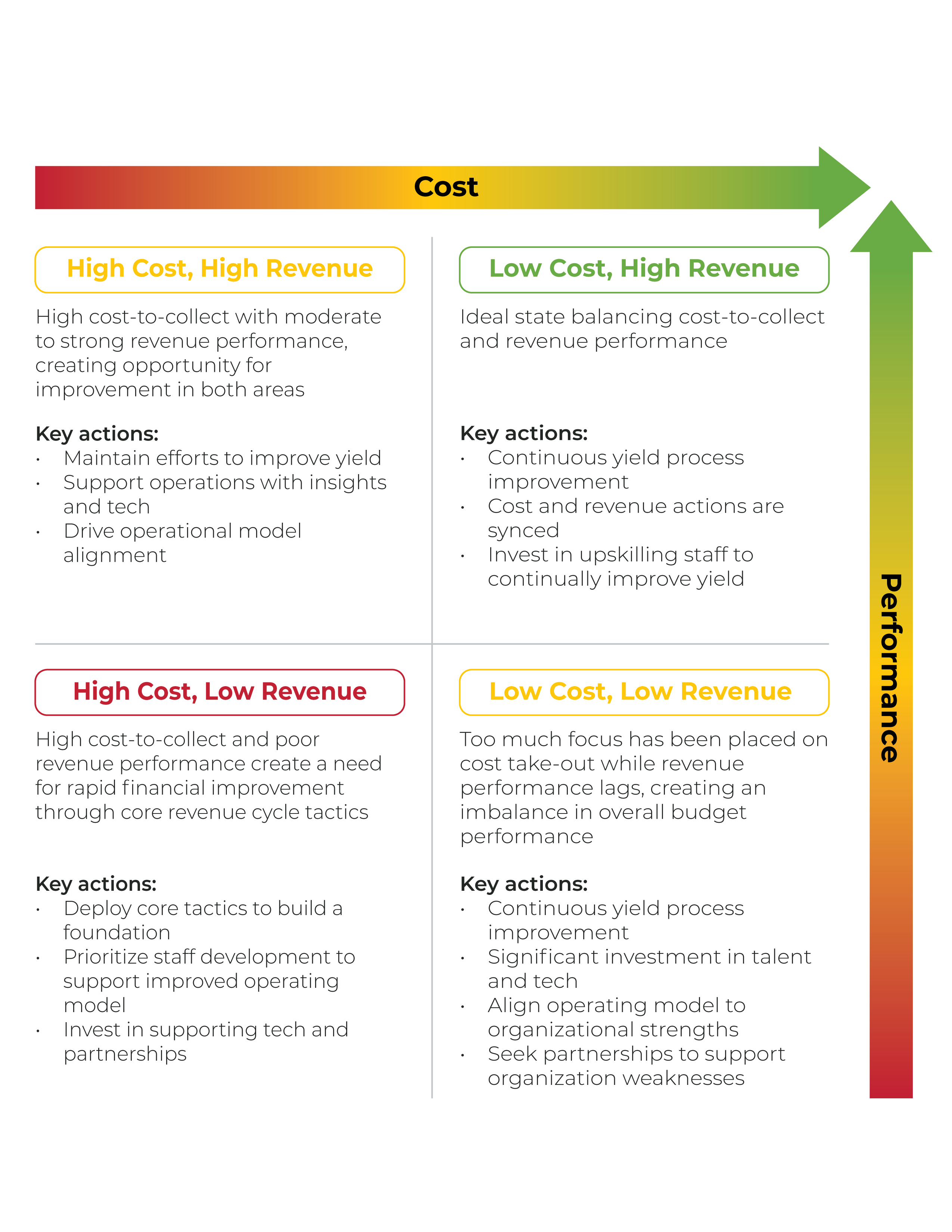In Brief
How organizations can get the best from their cost and net revenue performance
- Investment in the revenue cycle should strike a balance between improving yield in addition to taking out cost.
- Forward-thinking leaders are taking a more holistic approach to a meaningful transformation of their revenue cycle organizations.
- To improve both cost and yield, five essentials must be in place: skills of the future, consumer expectations, changing the model, insights into data, and automation moderation.
Increasing costs and inflation, diminishing reimbursement, and growing consumer trends are forcing healthcare leaders to reevaluate how they operate. Economic conditions have further stressed already-shrinking health system margins.
Leaders will continue to balance the need to reduce costs, increase revenue, and build stronger consumer relationships, calling for new, more holistic ways to think about meaningful transformation of their revenue cycle organizations.
Where do you stand? The continuum of cost and net revenue performance
Before organizations can reach an ideal state, they must first identify where the organization falls in relation to its cost and net revenue performance.
Organizations place a lot of emphasis on improving their cost-to-collect, which remains an essential but insufficient measure of total revenue cycle performance. Many have created an imbalance by focusing heavily on cost take-out with little investment in yield performance.
Benchmarks year-over-year for cost and yield also get harder to achieve, and healthcare will continue to raise the high-performance bar. That’s why healthcare organizations can’t pull back on shoring up foundational aspects of their revenue cycle while at the same time thinking about how they will keep improving.
The chart below shows the continuum that exists in performance based on real outcomes of a sample of healthcare organizations. Typical actions or levers can improve cost and net revenue, but the ideal state exists in the upper-right quadrant, which syncs the best of both cost and yield performance.

Five essentials for improving cost and yield in balance
Beyond the core actions and levers needed to improve performance, organizations that are moving cost and net revenue (yield) in balance have the following five essentials in place:
1. Skills of the future: The skill sets of leaders today do not meet the requirements of tomorrow. Traditionally, the best revenue cycle employees were proficient billers and collectors, but times have changed. Some of today’s strongest revenue leaders are data-driven problem solvers with a background in accounting, technology, manufacturing, and customer service.
Organizations should be investing in talent strategies and leadership development to recruit and develop critical thinkers who can see how each area of the revenue cycle connects internally within the department and to outside functions such as IT. This up-leveling of skills can be funded by transitioning more transactional tasks to lower-wage cost profiles such as offshoring.
Widespread cuts to hours and staff are not always the best tactic for staff effectiveness. As organizations invest in their people, they will be able to cut costs through more efficient use of the skill sets that produce increased revenue for the organization.
2. Consumer expectations: Tied closely to changing the model is a shift to designing revenue cycles that deliver a seamless consumer experience. With technology and digital platforms, consumer-centric revenue cycle models are evolving to adjust the patient experience at any point along their individual journey, based on the consumer’s emotional and physical needs.
Organizations are also emphasizing moving traditionally low-wage customer-facing jobs to higher-wage roles — another aspect of evolving skills for the future.
3. Change the model: Organizations are abandoning siloed, “production line” mentalities and rethinking the connectedness of front, middle, and back-office functions of the revenue cycle. The shift in the model moves away from business function excellence to drive business outcomes excellence that includes patient experience, maximizing reimbursement, and clinical outcomes. This change in thinking results in less variation in process and consumer experience, fewer touches-to-resolution, and more effective payor interactions.
In many cases, changing the model comes down to understanding the organization’s strengths and weaknesses and utilizing outside support to bolster existing expertise and close the gaps in shortfalls. New, innovative business models for outsourcing are helping leaders customize their business relationships to accelerate financial outcomes without losing focus on bigger transformational goals.
4. Insights: Data insights are at the core of revenue cycle excellence as it provides the ability to investigate and understand opportunities for continuous improvement.
Higher-performing organizations are investing in analytics that connect data points from health information systems (HIS), electronic health records (EHR), and other organizational systems, bringing the cost and revenue sides of the equation together in one place to make more balanced decisions.
5. Automation moderation: While much focus has been placed on automation as a quick fix to trim costs from the revenue cycle, this tech enabler comes after the other four essentials are in place. Once key metrics are understood and data is aggregated to drive meaningful insights, an organization can identify opportunities to build automation in a number of different ways through their HIS, bolt-on technologies, or to utilize robotic process automation (RPA) and artificial intelligence (AI) further to streamline processes.
The future of the healthcare revenue cycle will continue to demand a more balanced approach in which cost and yield move in sync. All of this is supported by focus and investment in new skills, business models, and technology that enable a more holistic approach and sustainability through continuous improvement.
